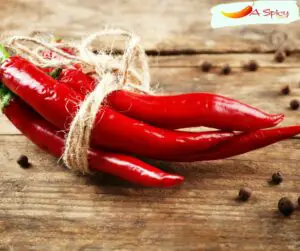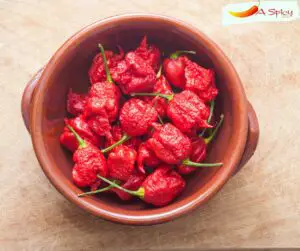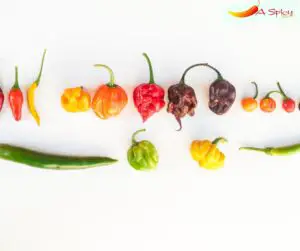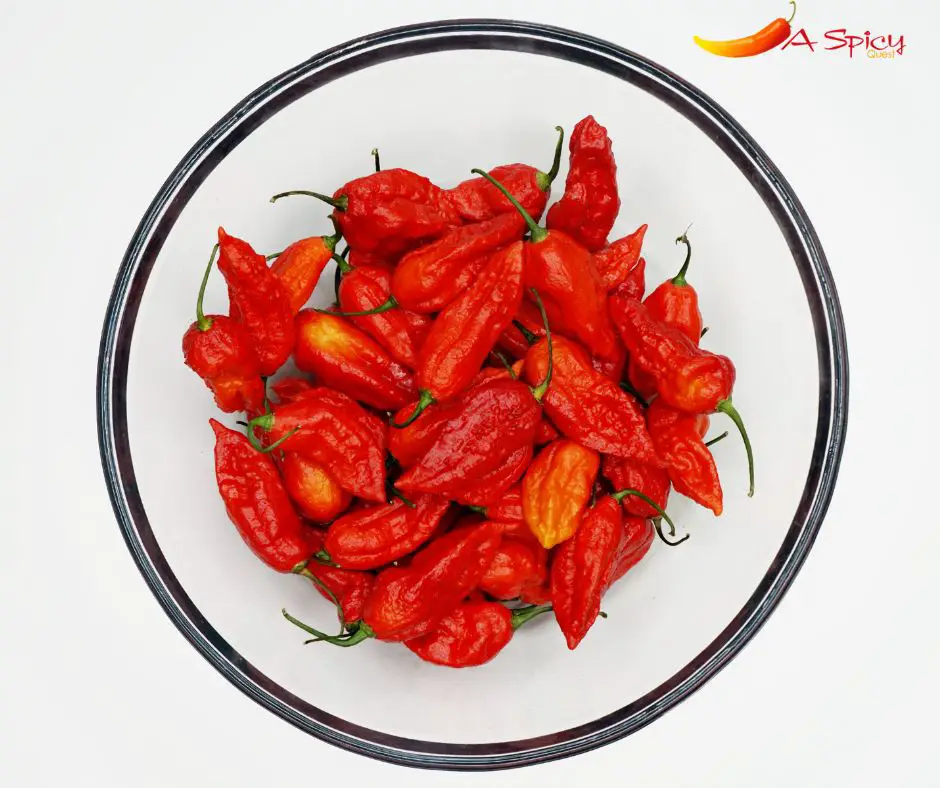
Ghost peppers are a type of chili pepper that grows on the Ghost Pepper plant. They’re known for their intense heat, with some varieties reaching over 1 million Scoville units—the unit of measurement used to determine how spicy food is. The ghost pepper gets its name from its eerie white color and lack of seeds (which makes it look “ghostly”).
So, how hot exactly is a ghost pepper? It’s one of the hottest peppers in the world, with a Scoville Scale rating of 1.04 million SHU. The Scoville Heat Unit (SHU) measures the spiciness of chili peppers; it’s based on dilution tests that use human tasters and chemical analysis.
What is the Origin of Ghost Peppers?
Ghost peppers are a variety of chili pepper that is native to the Indian subcontinent. These peppers can be found in a wide variety of colors, but they’re generally either white or yellow with red streaks.
They’re also known as Bhut Jolokia or Naga Jolokia – depending on where you live. “Bhut” means ghost and “Naga” refers to a group of people from India who love spicy food and consider it an art form.
What Foods Contain Ghost Peppers?
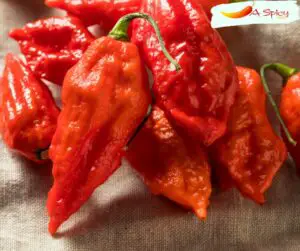
You can use ghost peppers in a variety of ways. The main uses for them are hot sauces, soups, and salsas. You can add them to chili for an extra kick. They also work great when added to stir-fry or marinades. If you’re looking for something more exotic than your standard red pepper, then consider adding some ghost peppers.
Health Benefits of Ghost Peppers
1. Weight loss
Ghost peppers are also known to be a powerful weight loss agent. The ghost pepper extract has been shown to help with weight loss in studies conducted on rats, so it’s not surprising that people who eat ghost peppers regularly have reported losing some weight as well.
Ghost peppers contain capsaicinoids which can help boost your metabolism and make you burn more fat during workouts, as well as curb your appetite! This makes them an excellent addition to any diet regimen.
2. Antioxidant
Ghost peppers are one of the most powerful spices in the world, and they’re also full of antioxidants. Antioxidants help to prevent damage to cells, which can contribute to cancer, heart disease, and inflammation. Although it can be difficult for many people to tolerate ghost pepper’s intense heat, it’s worth trying out if you’re looking for a spicy flavor with some added health benefits.
3. Anti-inflammatory
The ghost pepper is so hot that it can actually reduce inflammation, pain, and swelling. It helps with arthritis, psoriasis, and eczema too.
If you have any of these conditions or are looking for a natural way to lower your levels of inflammation then this is the pepper for you.
4. Cancer-fighting
The ghost pepper is one of the hottest peppers in the world. It’s also one of the most interesting because it has been shown to have some health benefits that could help prevent cancer and treat skin cancer.
The capsaicinoids found in the ghost pepper have been shown to kill cancer cells while leaving healthy cells alone. Capsaicinoids are also thought to be able to stop angiogenesis, which is when new blood vessels form from existing ones and can lead to tumor growth.
So what does this mean for you? If you want to protect yourself from certain types of cancers (and if you’re not prone to heartburn), then eating foods with capsaicinoids may help reduce your risk for certain kinds of diseases—and possibly even save your life!
5. Helps digestion
The ghost pepper has many benefits. It can help digestion and treat indigestion, constipation, and diarrhea. It also helps with irritable bowel syndrome and ulcers. Finally, it can be used to treat acid reflux.
Does Ghost Peppers Contain Capsaicin?
Yes, ghost peppers contain capsaicin. Capsaicin is the chemical that gives hot peppers their heat. It also has several other health benefits, including weight loss, and improved brain function, and can help prevent cancer and heart disease. Ghost pepper contains one of the highest amounts of capsaicin of any pepper on the Scoville Scale.
Side Effects of Ghost Peppers
Some people experience sweating, redness, headaches, and stomach cramps. If you’re allergic to capsaicin (the active chemical in peppers) the ghost pepper could cause anaphylaxis.
For those who want to try ghost peppers: it’s important not to eat them whole or with alcohol. When eating spicy food, always drink water between bites so you don’t end up vomiting.
Which is Hotter Ghost or Carolina Reaper?
The Carolina Reaper is not only the hottest pepper in the world, but it’s also one of my favorite peppers. It’s a hybrid of Red Habanero and Bhut Jolokia (Ghost Pepper).
Its heat range is between 1.579 million to 2.2 million Scoville Heat Units (SHU). That’s about 2.2 times hotter than Ghost Pepper on average.
How to Store Ghost Pepper
You should store your ghost pepper seeds in a cool, dry place with low humidity. This will help to preserve their freshness and prevent any mold growth. Ghost peppers can be kept for up to six months if stored properly.
If you buy more than one pack of ghost pepper seeds and want to keep them for a long period of time, you should store them in separate containers so that the flavors don’t mix together.
Medicinal Uses of Ghost Peppers
1. Ghost Peppers Are Used in Natural Remedies
In addition to being one of the hottest pepper in the world, ghost peppers are also used in natural remedies. The fruit of the plant is called bhut jolokia and has been used by native tribes in India for centuries as a cure for colds, insomnia, and headaches.
In fact, legend says that if you eat one ghost pepper before bedtime every night for a week straight without sleeping during that period—you’ll be cured of any illness or disease.
2. Used to Treat Indigestion, Colds, Coughs, and Fevers
The ghost pepper is frequently used to treat indigestion, colds, coughs, and fevers. Pepper has been found to be effective as a painkiller and at reducing inflammation.
3. Used to Treat Arthritis and Other Inflammatory Conditions
Ghost peppers are used to treat arthritis because they contain a compound known as capsaicin.
Capsaicin is an irritant that stimulates pain receptors in the skin, so when you eat it, your body registers that as pain. Since ghost peppers are extremely spicy and hot (the hottest pepper on Earth), eating them can cause an intense burning sensation in your mouth.
That same sensation also travels down through your digestive tract and into other parts of your body where it can send signals to reduce inflammation throughout your system.
This makes them ideal for treating arthritis and other inflammatory conditions like psoriasis or asthma or even just giving you temporary relief from aches and pains.
4. Used to Treat Acne and Psoriasis
You can use ghost peppers for acne, and psoriasis. There are many ways to do it, but I’ll explain one way that works best for me.
- Take a ghost pepper and mash it into a pulp in the palm of your hand
- Apply this pulp to the affected area of your skin using your hands (the more contact, the better)
- Leave this on until it dries out (about 30 minutes), then wash it off with warm water
Conclusion
If you’re looking to spice up your life, the ghost pepper is a good place to start! This spicy little pepper may have some health benefits and medicinal uses, but it can also cause some side effects. If you want to try eating or cooking with ghost peppers, make sure that you know what kind of heat level they will bring before taking them on.

